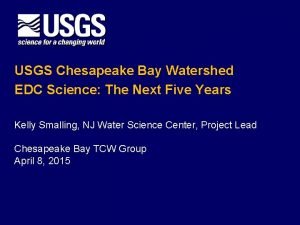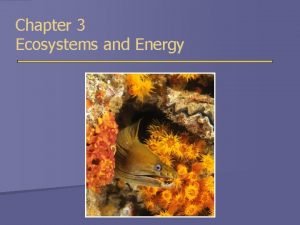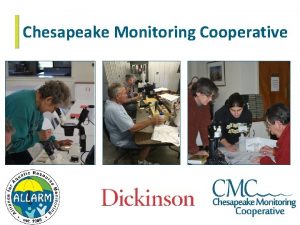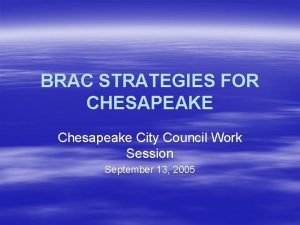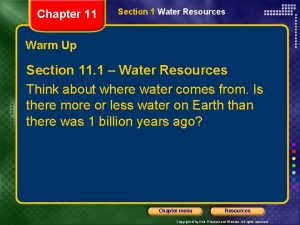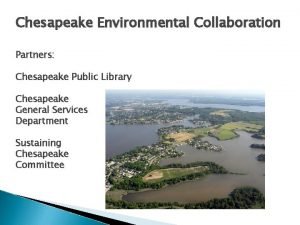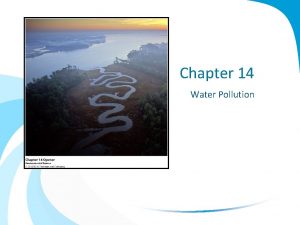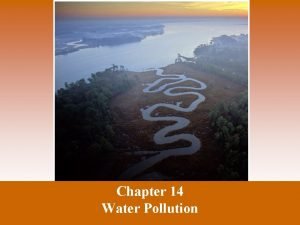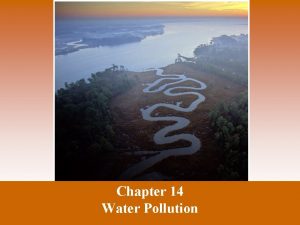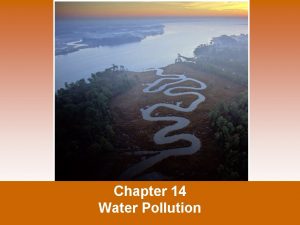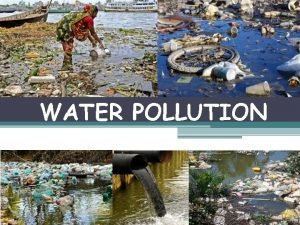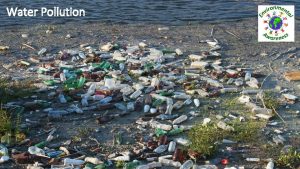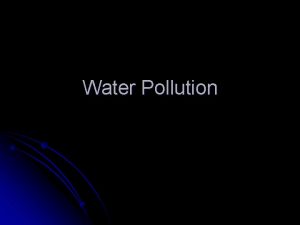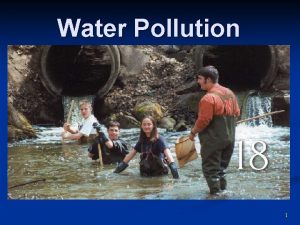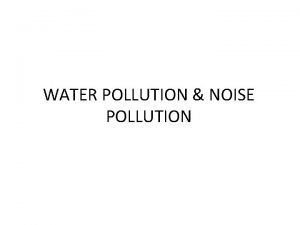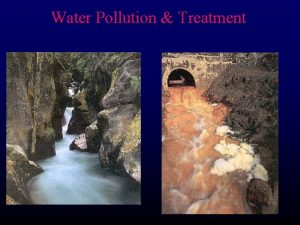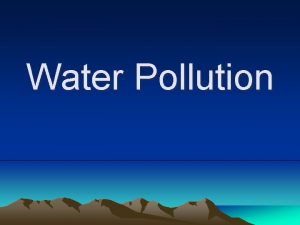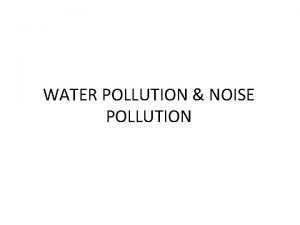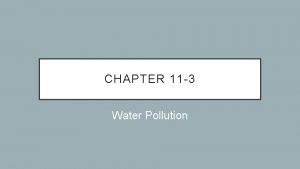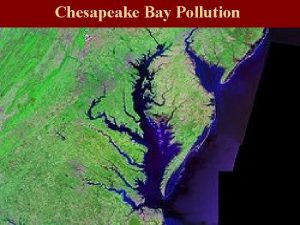Chapter 14 Water Pollution Water Pollution The Chesapeake





























- Slides: 29

Chapter 14 Water Pollution

Water Pollution: The Chesapeake Bay case study • The largest estuary in the United States. • Where does the large source of Nitrogen and Phosphorus in the Bay come from? • What does the buildup of these nutrients cause to happen in the bay? • How does the increase in sedimentation affect the Bay? • What happened to the largemouth and smallmouth bass? • Describe the Chesapeake Bay action Plan of 2000.

Water Pollution © Water pollution- the contamination of streams, rivers, lakes, oceans, or groundwater with substances produced through human activities and that negatively affect organisms. © List pollutants found in water: © Point sources- distinct locations that pump waste into a waterway. © Nonpoint sources- diffuse areas such as an entire farming region that pollutes a waterway.

Human Wastewater © Water produced by human activities such as human sewage from toilets and gray water from bathing and washing clothes or dishes. © Problem – many people throughout the world use the same water source for drinking, bathing, washing, and disposing of sewage. © List the three concerns about human wastewater as a pollutant:

Biochemical Oxygen Demand (BOD) 1. Oxygen-demanding wastes like bacteria that put a large demand for oxygen in the water © BOD- the amount of oxygen a quantity of water uses over a period of time at a specific temperature. © Lower BOD values indicate the water is less polluted and higher BOD values indicate it is more polluted by wastewater. © The more microbes grow, the more oxygen they demand. © Why is this problematic and what can it cause?

Nutrient Release 2. Nutrients that are released from wastewater decomposition can make the water more fertile causing eutrophication © Eutrophication is an abundance of fertility to a body of water. © Eutrophication is caused by an increase in nutrients, such as fertilizers. © Products of decomposition = nitrogen and phosphorus. Additional sources come from soaps and detergents. © Eutrophication cause a rapid growth of algae which eventually dies, causing the microbes to increase the BOD.

Common Diseases from Human Wastewater 3. Wastewater can carry a wide variety of disease-causing organisms. © Cholera - © Hepatitis A - © Typhoid fever - © Stomach flu - © Diarrhea - © 1. 2 billion people do not have access to safe drinking water. © 3. 1 million annual deaths from diarrheal diseases could be prevented with safe drinking water. © What is the best indicator species to use for potentially harmful water?

Treatments for Human and Animal Wastewater © Septic systems in rural areas - a large container that receives wastewater from the house. © Solids settle to the bottom and bacteria break down the sewage into sludge (primary treatment). © © Sludge must be removed every 5 -10 years. The liquid move through a pipe at the top of the tank and passes through perforated pipes that distribute the water through a leach field (secondary treatment) that are taken up by plants.

Treatments for Human and Animal Wastewater © Sewage Treatment Plants- centralized plants in areas with large populations that receive wastewater via a network of underground pipes. © Primary treatment is to remove solid waste material (sludge) and send to landfill or converted into fertilizer pellets. © Remaining wastewater undergoes a secondary treatment. © Secondary treatment includes aeration of the water to promote the growth of aerobic bacteria that emits a less offensive odor than anaerobic bacteria. © Remaining water is disinfected using chlorine, ozone, and/or ultraviolet light to kill any remaining pathogens. © Treated water is then released into nearby river or lake where it becomes part of the global water cycle again.


• • Treatments for Human and Animal Wastewater Sewage treatment plants are typically built to handle wastewater from local households, industries, and storm -water drainage. During heavy rains the combined storm water and wastewater can exceed the holding capacity and treatment plants are allowed to bypass their normal treatment and pump water directly into an adjacent body of water. Overflows of raw sewage occur approx 40, 000 times per year in the U. S. This can result in the contamination of:

Treatments for Human and Animal Wastewater © Manure lagoons- large, human-made ponds lined with rubber to prevent the manure from leaking into the groundwater. © After the manure is broken down by bacteria, it is spread onto fields as fertilizers. © Problems:

Heavy Metals and Other Substances that can threaten human Health and the Environment 1. Lead © Heavy metal, contaminates water when water passes through the pipes of older homes that contain lead lined pipes. © Damage the brain, nervous system and kidneys. 2. Arsenic © Occurs naturally in earth’s crust and can dissolve in groundwater. © Mining breaks up rocks and releases arsenic and industrial uses of arsenic for items such as wood preservatives can add to the amount. © Arsenic can be removed through fine membrane filtration, distillation and reverse osmosis, but costs money. © Associated with cancers of skin, lungs, bladder and kidneys. © Can take up to 10 years or more to show illnesses.


Heavy Metals and Other Substances that can threaten human Health and the Environment 3. Mercury © Naturally occurring heavy metal found in water as a result of human activities. © 2/3 of all mercury produced from humans comes from: © Mercury ends up in the water and bacteria convert it into inorganic mercury (methylmercury) which is highly toxic to humans. © Damages the central nervous system. © Bio magnification World mercury production varies:

Heavy Metals and Other Substances that can threaten human Health and the Environment 4. Acids © Industry releases sulfur dioxide and nitrogen dioxide into the atmosphere while burning fossil fuels. © In the atmosphere they get converted into sulfuric acid and nitric acid that returns to earth as either wet acid deposition or dry acid deposition. Consequence? © To combat the problem many facilities have installed coal scrubbers: © Pyrite contributes to the production of acidic water from mining sites. Colorado mining spill © Low p. H water can also cause many other harmful metal ions to become soluble and infiltrate the water.

Heavy Metals and Other Substances that can threaten human Health and the Environment 5. Synthetic compounds (pesticides, pharmaceuticals, industrial cleaners and hormones) © Can enter the water from industrial point sources where they are manufactured or from nonpoint sources when they are applied over large areas. © Can be toxic, cause genetic defects, interfere with growth and sexual development. © Pesticides problems: © Charleston, WV water crisis

Heavy Metals and Other Substances that can threaten human Health and the Environment Contaminants in U. S. streams

Heavy Metals and Other Substances that can threaten human Health and the Environment Perchlorates – used for rocket fuel. Cuyahoga River fire of 1969 in Ohio – due to the disposal of industrial compounds. What has happened since?

Oil Pollution 1989 – Exxon oil tanker crash = 41 million liters of oil 2010 – BP Oil explosion = 780 million liters of oil NASA view

Oil Pollution

List of Ways to Remediate Oil Pollution

Other Water Pollutants © Solid waste pollution (garbage) – 1997 discovery of the Great Pacific Garbage Patch (larger than size of Texas) Ted video

Other Water Pollutants © Sediment pollution (sand, silt and clay). © The transport of sediments by streams and rivers is a natural phenomena but sediment pollution is the result of human activities. © Human activities include: © List the effects of increased sediment from human activities:

Other Water Pollutants © © Thermal pollution – cool water is removed to cool machines and heated water is returned back to the natural supply. © List the environmental impacts: © Possible remedies: Noise pollution – sounds emitted by ships and submarines that interfere with animal communication are a major concern.

Water Laws © Clean Water Act- (1972) supports the “protection and propagation of fish, shellfish, and wildlife and recreation in and on the water”. © Maintain and when necessary restore the chemical, physical, and biological properties of natural waters. © Does not include the protection of groundwater. © Issued water quality standards that defined acceptable limits of various pollutants in U. S. waterways. © Controls how much pollution industries can discharge into the water.

Water Laws © Safe Drinking Water Act- (1974, 1986, 1996) sets the national standards for safe drinking water. © It is responsible for establishing maximum contaminant levels (MCL) for 77 different elements or substances in both surface water and groundwater.

Water pollution: make a difference

Working Toward Sustainability: Building “Green” Solutions to Wastewater Treatment
 Water and water and water water
Water and water and water water What were the chesapeake colonies
What were the chesapeake colonies Chesapeake colonies climate
Chesapeake colonies climate Surviving folk sports
Surviving folk sports Chesapeake colonies apush
Chesapeake colonies apush Why did francis west sail up the chesapeake
Why did francis west sail up the chesapeake Usgs chesapeake bay
Usgs chesapeake bay Chesapeake driving schools
Chesapeake driving schools Chesapeake bay decomposers
Chesapeake bay decomposers Jamestown chesapeake bay
Jamestown chesapeake bay Chesapeake bay food web
Chesapeake bay food web Landforms of virginia
Landforms of virginia Rubic cmc
Rubic cmc Chesapeake city council meeting
Chesapeake city council meeting Introduction of water pollution
Introduction of water pollution Chapter 11 section 3 water pollution
Chapter 11 section 3 water pollution Hình ảnh bộ gõ cơ thể búng tay
Hình ảnh bộ gõ cơ thể búng tay Ng-html
Ng-html Bổ thể
Bổ thể Tỉ lệ cơ thể trẻ em
Tỉ lệ cơ thể trẻ em Chó sói
Chó sói Chụp phim tư thế worms-breton
Chụp phim tư thế worms-breton Chúa sống lại
Chúa sống lại Các môn thể thao bắt đầu bằng tiếng đua
Các môn thể thao bắt đầu bằng tiếng đua Thế nào là hệ số cao nhất
Thế nào là hệ số cao nhất Các châu lục và đại dương trên thế giới
Các châu lục và đại dương trên thế giới Công của trọng lực
Công của trọng lực Trời xanh đây là của chúng ta thể thơ
Trời xanh đây là của chúng ta thể thơ Mật thư tọa độ 5x5
Mật thư tọa độ 5x5 Phép trừ bù
Phép trừ bù






